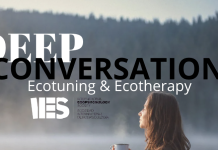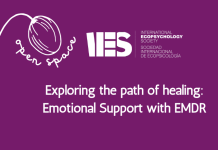The multiple forms of applied ecopsychology allow us to connect with the rest of nature according to our own preferences. Most of these practices focus primarily on sensory experience, mindful presence, and on building an emotional bond with the more-than-human nature. In addition to all these, I think that there is an equal need for biological knowledge, in the possession of which we may be able to notice connections and invisible processes in a landscape.
The participatory walks developed by the Hungarian Institute of Ecopsychology in 2019, are group sessions led by a biologist trained in ecopsychology, aimed at an experiential level, knowledge-based encounter with the living organisms, networks, patterns and processes of a specific area and the recognition and experiencing of our embeddedness in this system.
Small group or individual walks take place in various wetlands, meadows, forests or other areas rich in natural values. During the walks, we strive for reciprocity, as nature is more than simply a venue for recreation, a backdrop or instrument that serves our purposes – the primary goal of these activities is to initiate a shift in our perception and, accordingly our relationship with nature.
As with many other recreational programs in nature, reducing stress level and recharging our attentional capacity is also an important consideration, but beyond that, we try to connect with the particular living system, letting go of the exploitative, anthropocentric approach. Therefore, in addition to the preservation of health and recreation, connecting with the ecosystem through knowledge and experience also becomes an important consideration.
We achieve that effect by seeking fine balance between two different approaches. One of them is at the level of sensory, experiential connection, while the other is represented by the scientific (biological and ecological) knowledge. In my view, along with sensory experiences of connection, the transfer of scientific information is also an important part of the ecopsychological approach, as it is indispensable for the transformation of perspectives and then the paradigm shift, the acquisition of the ability to look at the ecosystem through different eyes, and to notice the connections and the correspondences along with the individual beings. As a result, it is not merely an emotional connection that is formed between the participants and the ecosystem, but also a conscious change of attitude based on knowledge that is beautifully energized by the emotional link.
Types of exercised used in Participatory Walks:
- Sensory awareness techniques help us anchor in the present moment, so these exercises are required mostly at the beginning. In addition to sensory awareness exercises, we use a number of other types of exercises.
- The carefully built-in biological information helps us see the currently invisible: the web of roots in the soil, tiny creatures invisible to the naked eye, or even large-scale processes happening in that habitat. Through information, connections can also be revealed before our eyes, which help us understand and experience the interconnectedness of living systems.
- When we encounter other living beings up close, we have the opportunity to let go of pre-fabricated stereotypes and see the other being in its own uniqueness: we recognize the similarity between us that lies in this wonderful, unrepeatable uniqueness.
- Furthermore, perceptual techniques that require abstraction help us rearrange captured mental images,
- while perspective-changing, zoom-in and zoom-out exercises provide a broader view of where we are located in space and time.
Through all these, participatory nature walks help us experience our own place in ecosystems, our close relationship with other living beings through the flow of material and energy, and thus the fact that we are not really separated or superior in the great network called nature – just one element among the many who is connected to the others by thousands of threads.













